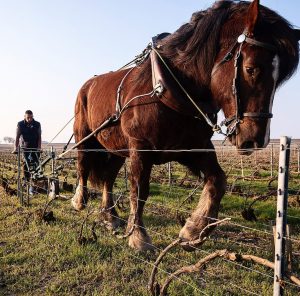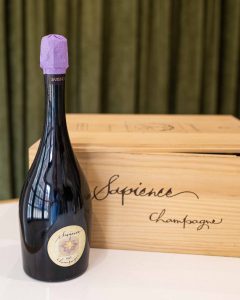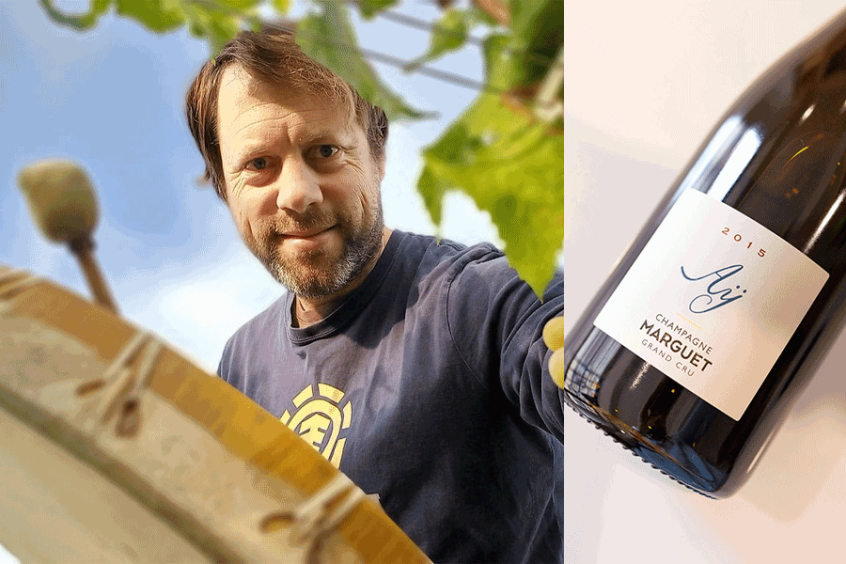Benoit Marguet was born into a winegrowing family, who had some truly great holdings, mostly in the village of Ambonnay. They farmed this land for many years, cultivating and selling fantastic quality grapes to many Champagne houses, including Krug.
In 2005, Benoit slowly started to take over control of the estate, and by 2008 he began focusing on producing Champagne under the Marguet name. It was at this time that he decided to make the switch to biodynamics. He strives to maintain spiritual and ecological balance within the vineyard, following the rhythmic cycles of nature, as well as the cosmic and lunar cycles. His methods are far from conventional, but his results are indisputably fantastic Champagnes.
Biodynamics & Balance
The Marguet family have always avoided the use of heavy machinery, and instead employ the use of horses to work the soil. Benoit believes that this allows you to work the soil in a gentle way which improves the well-being of the soil, as well as promoting the biodiversity of the vineyard. It is a common belief within the practice of biodynamics, as well as within th e school of regenerative viticulture, that by promoting the growth of flora and encouraging ecological balance in the vineyard, the grapes grown here will be of much better quality.
e school of regenerative viticulture, that by promoting the growth of flora and encouraging ecological balance in the vineyard, the grapes grown here will be of much better quality.
A key aspect of biodynamics in viticulture is the use of preparations, which are essentially homeopathic remedies used to fertilise the soil, ward off pests, and more generally, enhance the life forces in the vineyard. Benoit uses a wide variety of treatments, including nettles, rosewater, chamomile, and sage. Each treatment has its own purpose, for example rhubarb root can be used to prevent mildew.
The estate is certified by Demeter, the biodynamic federation who assess the holistic, ecological and ethical approaches of agriculture. Using preparations are a key requirement for every certified estate, and Benoit uses several across his holdings. For example, preparation 501, crushed quartz, is used to improve light reception and verticality of the plant in times where sunlight levels are lower. Another common preparation is 500, which uses manure, stuffed in cow horns which are buried throughout winter, then dug up and used as fertiliser. Whilst these methods may seem eccentric to many, they are the core of Benoit’s beliefs, and clearly produce excellent results.
Nothing in the Marguet production is done without thought. The biodynamic practices engulf every aspect of the estate, including the winery, juice flows purely by gravity from the press, into tank, then into barrels. These barrels also use carefully selected staves where the root and the leaf ends align.
Purity & Complexity of Yuman & Shaman
The Yuman and the Shaman create Marguet’s non-vintage range, though these wines are typically based predominantly on one year, with reserve wine blended in for complexity and depth. The base year of these wines is always indicated on the label, with the most recent iteration being the 21.
These wines are aged for roughly 18 months on the lees, and use no added SO2.
The Shaman uses Pinot Noir and Chardonnay from entirely Grand Cru vineyards in Ambonnay and Bouzy. Benoit produces both a white and a rosé, both offering richness, layers of striking complexity and character. They are wildly expressive of the terroir, with such freshness and elegance which is to be expected of all Marguet’s cuvées.
Crus, Lieux-Dits and the essence of terroir
Marguet craft a range of Cru cuvées, which each focus on Grand Cru plots, all of which offer unrivalled expression of terroir.
The Crus include Ambonnay, Bouzy, Avize, Chouilly, Oger, and Verzenay – all of which are renowned Champagne villages with their own character and style.
His Lieux-Dits, or single-vineyard, Champagnes showcase the finest detail of terroir, produced in much smaller quantities. Each Lieux-Dits is unique in its size, altitude, soil type and positioning, making each one individually suited to either Pinot Noir or Chardonnay. As a result, each cuvée is single-varietal.
Les Crayères, arguably one of their most sought-after wines made from 100% Chardonnay, from old vines planted in the 1950s and 60s, atop pure Campanian chalk soil. The roots soak up the terroir character and mineral depth. It is a truly wonderful wine, with only 1,500 bottles produced per year, it is a rare an exceptional Champagne.
Another Lieux-Dits which stands out is La Grande Ruelle, a plot planted to 100% Pinot Noir, sitting at 118 metres above sea level atop clay and brown limestone soil. This plot is situated within Ambonnay, a village renowned for their Pinot Noir, with this particular Lieux-Dits offering some of the finest examples. This is a structured, yet bright wine, with underlying spice and dark fruits alongside the citrus backbone.
So many more Lieux-Dits are prized by Marguet, and the differences between each plot, cru and wine are remarkable. Each represents nuance, personality and precision.
A special word for Sapience
 Sapience elevates Champagne to a new dimension – it looks to be the first prestige Champagne produced from certified organic grapes. This unique cuvée combines the grapes from three renowned biodynamic producers in the region – Chardonnay from David Leclepart, Pinot Noir from Benoit Lahaye, and Meunier from Vincent Laval. They come together to produce a ‘super-cuvée’, under the careful watch of Benoit Marguet.
Sapience elevates Champagne to a new dimension – it looks to be the first prestige Champagne produced from certified organic grapes. This unique cuvée combines the grapes from three renowned biodynamic producers in the region – Chardonnay from David Leclepart, Pinot Noir from Benoit Lahaye, and Meunier from Vincent Laval. They come together to produce a ‘super-cuvée’, under the careful watch of Benoit Marguet.
The first vintage was the 2006 vintage, and since then it has only been released in exceptional years where this style of Champagne thrives. The Sapience Oenothèque was a later addition which uses library stock, offering serious enthusiasts a more mature style with greater depth and power.
The Sapience is certainly a labour of love, and one which offers a spiritual experience for the serious Champagne enthusiast.
We are proud to work directly with Benoit Marguet, gaining access to some of his most intriguing and desirable wines. His newest releases should be landing with us this autumn, and if you are interested you can register your interest in these wines now.
Benoit’s fascinating range of cuvées offer such diverse styles, which are all so expressive not only of his attention to detail, but of the exceptional plots of land which he cultivates. The Crus make up his family’s historical vineyards, each with their own character and story to tell. His wines are age-worthy, intriguing, and certainly memorable. They are undoubtedly a must-try for any Champagne enthusiast.

